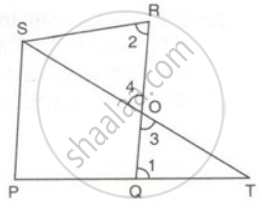Advertisements
Advertisements
प्रश्न
In the given figure, PQ ∥ SR ∥ MN, PS ∥ QM and SM ∥ PN. Prove that: ar. (SMNT) = ar. (PQRS).
उत्तर
SM ∥ PN
⇒ SM ∥ TN
Also, SR ∥ MN
⇒ ST ∥ MN
Hence, SMNT is a parallelogram.
SM ∥ PN
⇒ SM ∥ PO
Also, PS ∥ QM
⇒ PS ∥ OM
Hence, SMOP is a parallelogram.
Now, parallelograms SMNT and SMOP are on the same base SM and between the same parallels SM and PN.
∴ A(parallelogram SMNT) = A(parallelogram SMOP) ….(i)
Similarly, we can show that quadrilaterals PQRS is a parallelogram.
Now, parallelograms PQRS and SMOP are on the same base PS and between the same parallels PS and QM.
∴ A(parallelogram PQRS) = A(parallelogram SMOP) ….(ii)
From (i) and (ii), we have
A(parallelogram SMNT) = A(parallelogram PQRS).
APPEARS IN
संबंधित प्रश्न
PQRS is a parallelogram. PQ is produced to T so that PQ = QT. Prove that PQ = QT. Prove that ST bisects QR.
ABCD is a rectangle with ∠ADB = 55°, calculate ∠ABD.
Prove that if the diagonals of a parallelogram are equal then it is a rectangle.
PQRS is a parallelogram. T is the mid-point of RS and M is a point on the diagonal PR such that MR = `(1)/(4)"PR"`. TM is joined and extended to cut QR at N. Prove that QN = RN.
Prove that the line segment joining the mid-points of the diagonals of a trapezium is parallel to each of the parallel sides, and is equal to half the difference of these sides.
In a parallelogram PQRS, M and N are the midpoints of the opposite sides PQ and RS respectively. Prove that
MN bisects QS.
In the given figure, PQRS is a trapezium in which PQ ‖ SR and PS = QR. Prove that: ∠PSR = ∠QRS and ∠SPQ = ∠RQP
Prove that the diagonals of a parallelogram divide it into four triangles of equal area.
PQRS is a parallelogram and O is any point in its interior. Prove that: area(ΔPOQ) + area(ΔROS) - area(ΔQOR) + area(ΔSOP) = `(1)/(2)`area(|| gm PQRS)
In ΔABC, the mid-points of AB, BC and AC are P, Q and R respectively. Prove that BQRP is a parallelogram and that its area is half of ΔABC.
